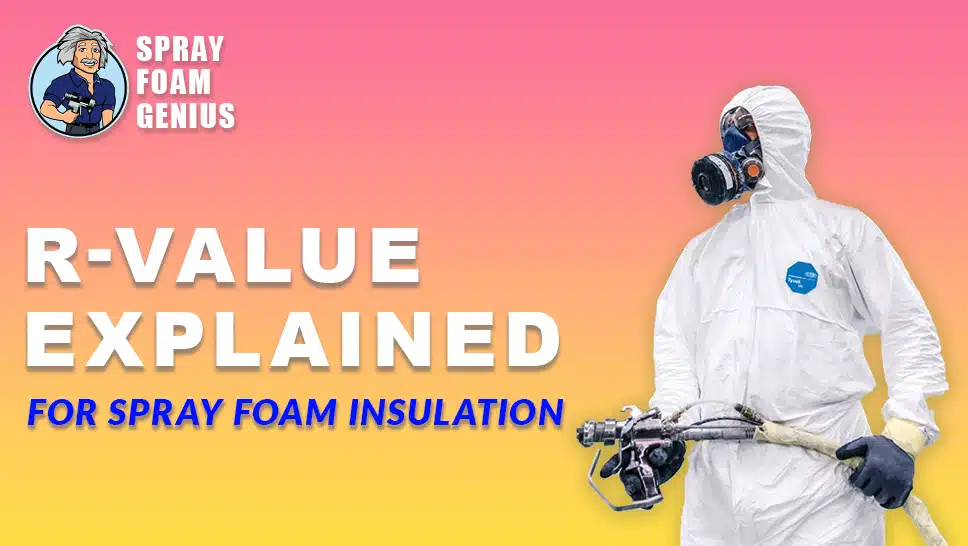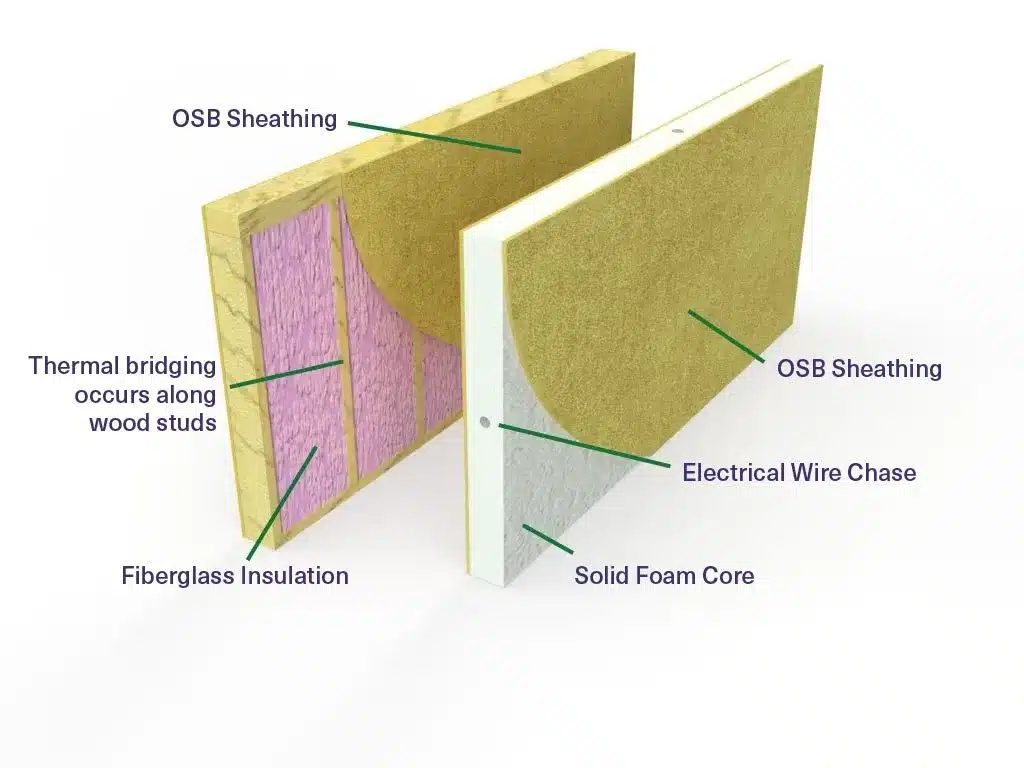
When it comes to creating a comfortable, energy-efficient home or business, insulation is key. Among the various types of insulation available, spray foam insulation stands out for its superior performance, thanks in part to its high R-value. But what exactly is the R-value, and why is it so important? In this comprehensive guide, we will delve into the concept of R-value, explain how it relates to spray foam insulation, and explore why this combination is an excellent choice for those seeking optimal energy efficiency and comfort in their buildings.
What is the R-value?
R-value is a term you’ll often encounter when discussing insulation, but what does it mean? R-value measures the ability of an insulating material to resist the flow of heat. Essentially, the higher the R-value, the better the material is at insulating, which means it will be more effective at keeping heat inside your building during the winter and outside during the summer.
R-value is expressed in units per inch of thickness. For example, if an insulating material has an R-value of R-5 per inch, a 2-inch thick layer of that material would have a total R-value of R-10. This measurement allows for easy comparison between different types of insulation and helps determine how much insulation is needed to achieve the desired level of thermal resistance.
The significance of the R-value cannot be overstated. It plays a critical role in the overall energy efficiency of a building, directly affecting heating and cooling costs. In regions with extreme temperatures, having insulation with a high R-value is particularly important, as it ensures that the building remains comfortable while minimizing energy use.
The Science Behind R-Value
To understand why R-value is so crucial, it’s helpful to know a bit about the science behind it. Heat naturally moves from warmer areas to cooler ones, a process known as heat transfer. In a building, heat can transfer in three ways: conduction (through solid materials), convection (through air movement), and radiation (through electromagnetic waves).
Insulation primarily combats conduction, the transfer of heat through solid materials. When you add insulation to a wall, roof, or floor, you’re creating a barrier that slows down the flow of heat, keeping warm air where it belongs—inside during the winter and outside during the summer. The effectiveness of this barrier is what the R-value measures.
However, not all insulating materials are created equal. Different materials have different levels of thermal resistance, which is why they have different R-values. For instance, fiberglass insulation, one of the most common types, has an R-value of about R-2.2 to R-3.8 per inch. On the other hand, spray foam insulation can have an R-value as high as R-6.5 per inch, making it far more effective at resisting heat transfer.
Types of Insulation and Their R-Values

To put spray foam insulation into context, let’s take a look at the R-values of other common types of insulation:
- Fiberglass Insulation: Fiberglass is perhaps the most widely used insulation material in residential construction. It’s made from fine glass fibers and comes in the form of batts, rolls, or loose-fill. The R-value of fiberglass insulation typically ranges from R-2.2 to R-3.8 per inch. While it’s inexpensive and easy to install, it doesn’t offer the highest level of thermal resistance and can be prone to air leaks.
- Cellulose Insulation: Made from recycled paper products treated for fire resistance, cellulose insulation has an R-value of R-3.2 to R-3.8 per inch. It’s often used in attics and wall cavities. Although it provides better thermal performance than fiberglass, cellulose can settle over time, reducing its effectiveness.
- Rigid Foam Insulation: Rigid foam boards, made from materials like polystyrene or polyisocyanurate, offer an R-value between R-3.8 and R-5.0 per inch. These boards are often used in exterior wall sheathing or foundation insulation. While rigid foam provides good thermal resistance, it requires precise installation to avoid gaps and thermal bridging.
- Spray Foam Insulation: Spray foam insulation comes in two main types—open-cell and closed-cell. Open-cell spray foam has an R-value of about R-3.5 to R-4.0 per inch, while closed-cell spray foam has an R-value ranging from R-6.0 to R-7.0 per inch. This makes spray foam one of the most effective insulation materials available. In addition to its high R-value, spray foam also creates an airtight seal, which significantly enhances its insulating power.
Spray Foam Insulation: The R-Value Champion
Given the above comparisons, it’s clear that spray foam insulation offers some of the highest R-values among common insulation materials. But why does this matter so much?
Superior Thermal Resistance
The high R-value of spray foam insulation means that it provides superior thermal resistance compared to other insulation materials. This is particularly important in areas of a building that are exposed to extreme temperatures, such as exterior walls, roofs, and attics. With spray foam, less material is needed to achieve a high level of insulation, which can be a significant advantage in spaces where there is limited room for thick insulation layers.
Air Sealing Capabilities
One of the most significant advantages of spray foam insulation is its ability to create an airtight seal. Unlike fiberglass or cellulose, which can leave gaps and allow air to pass through, spray foam expands upon application, filling every nook and cranny. This not only boosts the R-value but also prevents drafts, moisture infiltration, and the movement of air through walls, ceilings, and floors.
This airtight seal is critical because air leaks can significantly reduce the effectiveness of insulation. Even a small gap can allow a substantial amount of heat to escape in the winter or enter in the summer, leading to higher energy bills and reduced comfort. Spray foam’s combination of high R-value and air sealing makes it one of the most effective ways to insulate a building.
Moisture Resistance
Closed-cell spray foam insulation, in particular, offers additional benefits beyond just thermal resistance. It acts as a vapor barrier, preventing moisture from penetrating the building envelope. This is crucial in areas prone to high humidity or where condensation could lead to mold growth and structural damage.
Moisture resistance is an often-overlooked factor in insulation performance. Wet insulation loses its effectiveness because water conducts heat much better than air. With closed-cell spray foam, you not only get a high R-value but also protection against moisture, which helps maintain the insulation’s performance over time.
The Benefits of High R-Value Spray Foam Insulation
Investing in spray foam insulation with a high R-value brings numerous benefits that go beyond just energy savings. Here are some of the key advantages:
1. Enhanced Energy Efficiency
The primary benefit of high R-value spray foam insulation is improved energy efficiency. By reducing heat transfer, spray foam helps maintain a consistent indoor temperature, reducing the need for heating and cooling. This translates to lower energy bills and a smaller carbon footprint.
Buildings insulated with spray foam often see a dramatic reduction in energy consumption. The combination of high R-value and air sealing means that HVAC systems don’t have to work as hard to keep the interior comfortable, which can lead to substantial savings over time.
2. Improved Indoor Comfort
With better insulation, your home or business will be more comfortable throughout the year. High R-value spray foam keeps your living or working space warmer in the winter and cooler in the summer, eliminating hot or cold spots and providing a more consistent environment.
Moreover, the airtight seal created by spray foam helps reduce drafts and noise from outside, further enhancing comfort. This is particularly beneficial in busy urban areas or near highways where noise pollution can be a concern.
3. Increased Property Value
Energy efficiency is a key selling point in today’s real estate market. Homes and businesses with high-quality insulation, especially spray foam, are often valued higher because of their lower operating costs and improved comfort. Potential buyers are increasingly looking for properties that offer energy efficiency as part of their overall value.
By investing in high R-value spray foam insulation, you not only enjoy immediate benefits in terms of energy savings and comfort but also increase the long-term value of your property.
4. Durability and Longevity
One of the standout features of spray foam insulation is its durability. Unlike other types of insulation that can sag, settle, or degrade over time, spray foam retains its shape and insulating properties for the life of the building. This long-lasting performance means that you won’t have to worry about replacing or upgrading your insulation in the future.
The moisture resistance of closed-cell spray foam also contributes to its longevity. By preventing water infiltration, it protects your building’s structure and helps maintain the effectiveness of the insulation over time.
5. Environmental Impact
Spray foam insulation can also have a positive impact on the environment. By reducing the amount of energy needed to heat and cool your home or business, you’re also reducing the greenhouse gases associated with energy production. Additionally, because spray foam insulation lasts so long, it reduces the need for replacement, which in turn reduces waste and the demand for new materials.
Why Professional Installation Matters
While the benefits of spray foam insulation are clear, it’s important to note that achieving these benefits depends on proper installation. Spray foam insulation requires specialized equipment and expertise to ensure that it is applied correctly. Improper installation can lead to uneven coverage, reduced R-value, and potential air leaks, negating the advantages of spray foam.
At Spray Foam Genius Marketing, we understand the importance of professional installation. We connect you with experienced spray foam insulation contractors who are trained to assess your insulation needs, recommend the best type of spray foam for your project, and install it with precision.
Invest in Your Property’s Future with High R-Value Spray Foam Insulation
Understanding the R-value of insulation is crucial for making informed decisions about how to insulate your home or business. Spray foam insulation, with its high R-value, offers unmatched thermal resistance, air sealing, and moisture protection, making it an ideal choice for those looking to maximize energy efficiency and comfort.
Whether you’re building a new property, renovating an existing one, or simply looking to upgrade your insulation, spray foam is a smart investment that pays off in energy savings, increased property value, and long-lasting performance.
If you’re ready to take the next step, contact us at Spray Foam Genius Marketing. We specialize in connecting you with expert spray foam insulation contractors who can provide professional installation tailored to your needs.
Call us at 877-840-FOAM for USA and 844-741-FOAM for Canada visit our website at sprayfoamgeniusmarketing.com, or email us at [email protected] to get started.
By choosing spray foam insulation, you’re investing in a more energy-efficient, comfortable, and valuable future for your home or business.
- Social Media Marketing for Spray Foam Businesses: What Works in 2025? - February 6, 2025
- Best SEO Strategies for Spray Foam Insulation Contractors to Rank #1 on Google - February 6, 2025
- What is Spray Foam Insulation? Benefits and Applications - February 5, 2025

